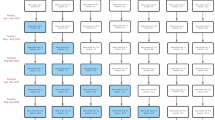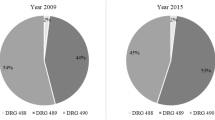Abstract
Background
Antiretroviral (ARV) drugs account for >70% of the direct costs of HIV care. Changing practices in the use of ARV drugs may have major cost implications for the care budget within a regional population.
Objective
To characterize and quantify the precise changes in the use of ARV within an entire HIV-infected population and to develop an approach to monitor the cost impact of future changes on the ARV budget. Design, Setting, and Participants: Socio-demographic, clinical, and primary-costing data were obtained from all 1218 HIV-positive patients receiving HIV care and living within southern Alberta, Canada between 1995 and 2003.
Main Outcome Measures
Mean per patient per month (PPPM) costs in $Can (2003 values) were used for the basis of comparison. Actual and predicted changes in costs are presented as percentage changes.
Results
After increasing 226% between 1996 and 1998, total PPPM ARV costs climbed only 6.7% from 1998 and 2003. Four counterbalancing forces contributed to this relative stabilization in costs: (i) the increased use of four or more ARV drugs to treat resistant HIV; (ii) the use of newer, more expensive ARV drugs (both [i] and [ii] increased total ARV costs by 22%); (iii) a delay in initiating ARV therapy to a lower CD4 count threshold; and (iv) the increased use of treatment interruptions (both [iii] and [iv] decreased total ARV costs by 15.3%). Increased or decreased use of these practices differentially affected mean ARV costs by 5–25% or more.
Conclusions
Changing medical practices in terms of ARV use may have a major impact on the ARV budget. Detailed knowledge of both the entire HIV population being served, along with comprehensive information on current and planned changes in ARV use are essential for projecting both immediate and longer term funding.









Similar content being viewed by others
References
Palella FJ, Delaney KM, Moorman AC, et al. Declining morbidity and mortality among patients with advanced human immunodeficiency virus infection. N Engl J Med 1998; 338: 853–60
Carpenter CC, Fischl MA, Hammer SM, et al. Antiretroviral therapy for HIV infection in 1997. Updated recommendations of the International AIDS Society-USA panel. JAMA 1997; 277: 1962–9
Hogg, RS, Heath KV, et al. Improved survival among HIV-infected individuals following initiation of antiretroviral therapy. JAMA 1998; 279: 450–4
Ho DD. Time to hit HIV, early and hard. NEJM 1995; 333: 450–1
McDonald CK, Kuritzkes DR. Human immunodeficiency virus type 1 protease inhibitors. Arch Intern Med 1997; 157(9): 951–9
Pakyz A, Israel D. Overview of protease inhibitors. J of Amer Pharm Assn 1997; NS37(5): 543–51
Katlama C. Review of NNRTI’s: ‘today and tomorrow’. Int J Clin Pract 1999; Suppl. 103: 16–20
Arribas J. Comparison of NNRTIs in antiretroviral-nalve patients. Int J STD AIDS 2001; 12 Suppl. 4: 3–9
Deeks SG. Determinants of virological response to antiretroviral therapy. Clin Infect Dis 2000; 30 Suppl. 2: S177–84
Miller LG, Hays RD. Measuring adherence to antiretroviral medication in clinical trials. HIV Clinical Trials 2000; 1(1): 36–46
Chesney MA. Factors affecting adherence to antiretroviral therapy. Clin Infect Dis 2000; 30 Suppl. 2: S171–6
Chesney MA, Ickovics J, Hecht FM, et al. Adherence: a necessity for successful HIV combination therapy. AIDS 1999; 13 Suppl. A: S271–8
Rutherford GW, Feldman KA, Kennedy GE. Three- or four versus two-drug antiretroviral maintenance regimens for HIV infection. Cochrane Database Syst Rev 2000; (2): CD002037
Hermans P. Current review and clinical management of patients with primary HIV-1 infection: limits and perspectives. Biomed Pharmacother 2001; 55(6): 301–7
MacArthur RD. Antiretroviral therapy. Sequencing antiretrovirals. AIDS Read; 10(6): 359–64
Goldscmidt RH, Balano KB, Legg JJ, et al. Individualized strategies in the ear of combination antiretroviral therapy. J Am Board Fam Pract 1998; (2): 158–65
Siliciano RF. Latency and reservoirs for HIV-1. AIDS 1999; 13 Suppl. A: S49–58
Siliciano JD, Siliciano RF. Latency and viral persistence in HIV-1 infection. J Clin Invest 2000; 106(7): 839–45
Finzi D, Blankson J, Siliciano JD, et al. Latent infection of CD4+ T cells provides a mechanism for lifelong persistence of HIV-1, even in patients on effective combination therapy. Nat Med 1999; 5: 512–17
Dybul M, Fauci AS, Barlett JC, et al. Guidelines for using antiretrovial agents among HIV-infected adults and adolescents. Ann Int Med 2002; 137(5): 381–433
Yeni PG, Hammer SM, Carpenter CC, et al. Antiretroviral treatment for adult HIV infection in 2002: updated recommendations of the International AIDS Society-USA Panel. JAMA 2002, 35
Eggar M, May M, Chene G, et al. Prognosis of HIV-infected patients starting highly active antiretroviral therapy: collaborative analysis of prospective studies. Lancet 2002; 360(9327): 119–29
Herschel B. Planned interruptions of anti-HIV treatment. Lancet Infect Dis 2001; 1(1): 53–9
Moss RB, Jensen FC, Carlo DJ, et al. The strategy of immunologic control of HIV-1 with structured treatment interruptions (STIs). Curr Drug Targets Infect Disord 2001; 1(1): 11–7
Lori F, Foli A, Lisziewicz J. Structured treatment interruptions as a potential alternative therapeutic regimen for HIV-infected patients: a review clinical data and future prospects. J Antimicrob Chemother 2002; 50(2): 155–60
Lisziewicz J, Lori F. Structured treatment interruptions in HIV/AIDS therapy. Microbes Infect 2002; 4(2): 207–14
Deeks SG, Martin JN. Reassessing the goal of antiretroviral therapy in the heavily pre-treated HIV-infected patient. AIDS 2001; 15: 117–119
Montaner JSG, Harrigan RP, Janke, N, et al. Multiple drug rescue therapy for HIV-infected individuals with prior virologic failure to multiple regimens. AIDS 2001; 15: 61–9
Mellors J, Montaner J. Salvage therapy for HIV-1 infection — the challenge grows. Lancet 2000 Apr 22; 355(9213): 1435
Tramarin A, Campostrini S, Postma MJ, et al. A multicentre study of patient survival, disability, quality of life, and cost of care among patients with AIDS in Northern Italy. Pharmacoeconomics 2004; 22(1): 43–53
Bozzette SA, Joyce G, McCaffrey DF, et al. Expenditures for the care of HIV-infected patients in the era of highly active antiretroviral therapy. N Engl J Med 2001; 344(11): 817–31
Krentz HB, MC Auld, MJ Gill. The changing direct costs of medical care for patients with HIV/AIDS, 1995–2001. CMAJ 2003; 169(2): 106–110
Mocroft A, Ledergerber B, Katlama C, et al. Decline in the AIDS and death rates in the EuroSIDA study: an observational study. Lancet 2003; 362(9377): 22–9
Mocroft A, Phillips AN, Friis-Moller N, et al. Response to antiretroviral therapy among patients exposed to three classes of antiretrovirals: results from the Euro SIDA study. Antivir Ther 2002 7(1): 21–30
Ledergerber B, Egger M, Opravil M, et al. Clinical progression and virological failure on highly active antiretroviral therapy in HIV-1 patients: a prospective cohort study. Swiss HIV Cohort Study. Lancet 1999; 353(9156): 863–8
Mocroft A, Brettle R, Kirk O, et al. Changes in the cause of death among HIV positive subjects across Europe: results from the EuroSIDA study. AIDS 2002; 16(12): 1663–71
PLATO Collaboration. Predictors of trend in CD4-positive T-cell count and mortality among HIV-1-infected individuals with virological failure to all three antiretroviral-drug class. Lancet 2004; 364: 51–62
Palella FJ Jr, Deloria-Knoll M, Chmiel JS, et al. Survival benefit of initiating antiretroviral therapy in HIV-infected persons at different CD4 cell strata. Ann Intern Med 2003; 138: 620–6
Lance HC, Neaton JD. When to start therapy for HIV infection: a swinging pendulum in search of data. Ann Intern Med 2003; 138: 680–1
Sendi PP, Bucher HC, Harr T, et al. Cost effectiveness of highly active antiretroviral therapy in HIV-infected patients. Swiss HIV Cohrt Study. AIDS 1999; 13(9): 1115–22
Acknowledgments
The authors wish to acknowledge Michael Henry for his data collection expertise that contributed greatly to this paper. Funding for this research was supported by a grant from the Canadian Institutes of Health Research. The authors have no potential conflicts of interest that are directly relevant to the contents of this manuscript.
Author information
Authors and Affiliations
Corresponding author
Rights and permissions
About this article
Cite this article
Krentz, H.B., Gill, M.J. Impact of Practice Changes on an Antiretroviral Budget in an HIV Care Program. Dis-Manage-Health-Outcomes 13, 209–217 (2005). https://doi.org/10.2165/00115677-200513030-00006
Published:
Issue Date:
DOI: https://doi.org/10.2165/00115677-200513030-00006




